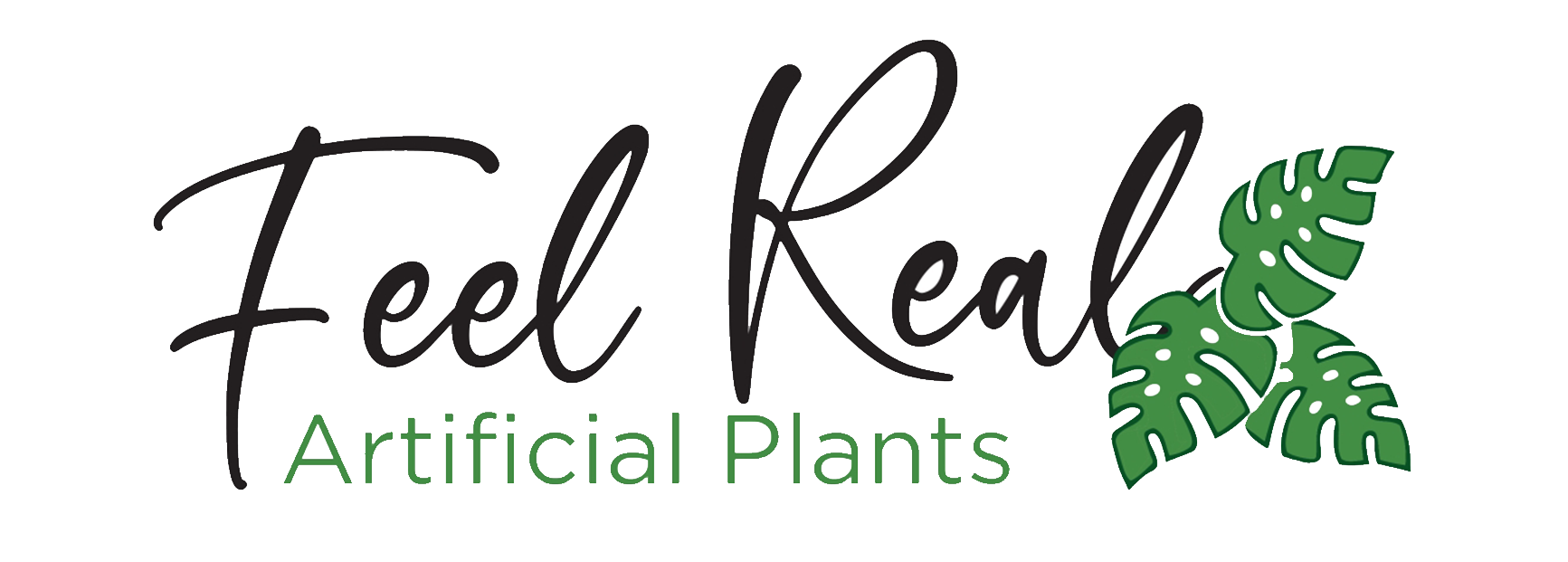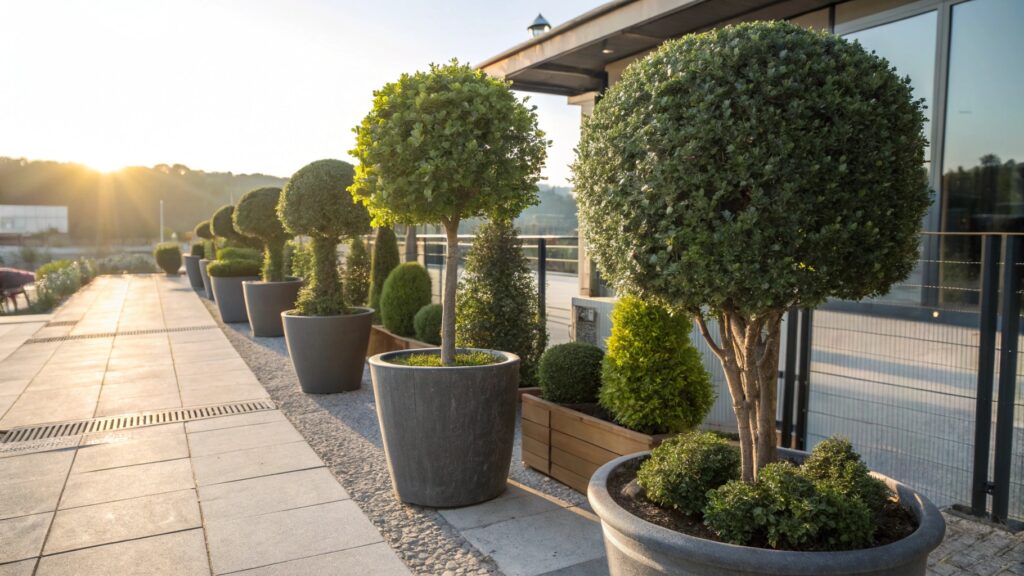The lifespan of plastic plants varies greatly. Key factors influencing lifespan include material quality, built-in UV protection or temporary sprays, weather exposure, construction quality, and proper maintenance. Premium indoor artificial plants can last 10-15 years or more with minimal maintenance. Anti-UV outdoor plants typically last 5-8 years. Non-UV-protected plants might only last a season to a couple of years.
Last Updated: 5th, June 2025 | Estimated Reading Time: 7 minutes
Can You Put Fake Plants Outside?
Yes, you can put fake plants outside, but only specific types designed for exterior use will maintain their appearance and structural integrity. Standard indoor artificial greenery will quickly deteriorate when exposed to weather elements, sun exposure, and temperature fluctuations.
Outdoor artificial plants differ significantly from their indoor counterparts. They’re manufactured with UV-stabilized materials that resist fading and becoming brittle under constant sun exposure. The leaves are typically made from polyethylene or high-grade silk treated with protective coatings, while stems use weather proof wire cores wrapped in protective materials. With anti-UV treatments, artificial tropical plants and shrubs can be put on your patio and keep green for years.

Do Fake Plants Fade in the Sun?
Yes, especially those not specifically designed for outdoor use or lacking UV protection, will fade in direct sunlight over time. The ultraviolet (UV) rays from the sun are the primary culprits, breaking down the color pigments in the plant’s materials, leading to a bleached appearance. However, quality outdoor fake plants are often treated with UV inhibitors or made from UV-stable materials to significantly slow down this fading process, maintaining their vibrancy for much longer.
What is the Average Lifespan of High-Quality Artificial Plants?
Premium artificial plants have extended durability. Indoor plants made from high end polyethylene (PE) can maintain their structural integrity and appearance for 10–15 years. High-quality outdoor artificial plants, specifically those with robust UV protection and made from durable materials like polyethylene, can typically last anywhere from 5 to 10 years, and sometimes even longer.
The key is “high-quality.” Cheaper, non-UV treated options might only last a season or two before noticeably degrading. So, for sustained beauty, investing in better grade outdoor faux plants pays off significantly in the long run for your outdoor decor.
We use premium pigments that resist fading and incorporate UV inhibitors directly into the plastic or fabric during production. Our outdoor plants meet ISO 4892-3 standards, maintaining >90% color retention after 10 years of equivalent Florida sunlight exposure. They are critical for commercial application like hotel facades or coastal resorts.

What Key Factors Determine The Lifespan of Fake Plants?
Material quality, UV protection level, installation method, and maintenance frequency are the four primary factors that determine how long your artificial plants will last.
Material composition forms the foundation of artificial plant longevity. High-density polyethylene (HDPE) leaves resist cracking and brittleness better than thin plastic alternatives. Quality silk materials treated with protective coatings maintain flexibility and color better than untreated fabrics.
Construction integrity is also the key for outdoor plant, including robust internal wireframes, secure leaf/stem attachments, and sturdy bases (especially for large trees like potted palms). Wire stems with galvanized or powder-coated finishes prevent rust and structural failure. For outdoor use, the type of UV protection are essential. The inherent, compounded UV stability vastly outperforms temporary sprays that wash away.

The environment also plays a huge role, such as intense sunlight, high winds, heavy rain, snow, coastal salt air, and even indoor factor. Installation quality is crucial, too. Improper anchoring or fixing leads to stress and potential failure. Finally, maintenance though minimal also impact longevity. Regular cleaning prevents ingrained grime, occasional rinsing outdoors or applying UV spray boosters mitigate environmental damage.
| Factor | Key Consideration for Longevity | Impact Level |
|---|---|---|
| Material Quality | Premium PE/PU vs. Low-grade PVC/Fabric | High |
| UV Protection | Inherent/Compounded vs. Topical Spray (Outdoor) | Critical |
| Construction | Strong Frame, Secure Connections, Stable Base | High |
| Environment | UV Index, Wind Load, Precipitation, Pollutants | High |
| Installation | Proper Anchoring/Fixing, Weight Distribution | Medium-High |
| Maintenance | Regular Cleaning, Protective Measures (as needed) | Medium |
Does Proper Maintenance Extend the Life of Fake Plants?
Indeed, proper care significantly extend both the visual appeal and the structural integrity of artificial decoration plants. Imitation plants are designed to be low-maintenance. For indoor plants, regular dusting (using feather dusters, or microfiber cloths) is OK. Cleaning prevents dust from becoming deeply ingrained, especially on textured leaves or fabrics. And, keeping your plants out of prolonged, direct sunlight also minimizes slow fading over many years.
For outdoor plants, maintenance plays an even more critical role. Periodic rinsing with water removes surface dirt, grime, and corrosive pollutants like salt spray or rain residue, which can slowly degrade materials. For plants with inherent UV protection, this helps maintain surface cleanliness. And for those applying on topical sprays, cleaning is essential before reapplication. Also do not forget to check and ensure secure anchoring or potting prevents wind damage.

What Are the Signs That Artificial Plants Need Replacing?
The most obvious indicators involve material degradation and uneven color fading. You may find the vibrant greens become pale or yellowish, robbing the plant of realism. Check for brittleness, where leaves or stems crack, split, or break easily upon handling. They are the sign that the plasticizers have degraded, often due to UV exposure or age. Obvious tears, holes, or frayed edges on leaves or petals also indicate the the plant need to be replaced.
Beyond material, assess the plant’s construction and appearance. Persistent drooping of branches or stems happens. And you can not reshape points to internal wire fatigue or failure at connection points.Tall plants or trees leaning precariously suggest issues with the internal frame or potting stability. Aesthetic looking is also important: if the plant is covered in irreversible grime that cleaning cannot remove, or if its style simply looks outdated and no longer fits the decor, it’s time to replace.
Lifespan of the artificial plant varies, but quality raw materials, UV protection, and good care significantly extend their beauty and longevity. Artificial plants and trees are proved to be the best indoor and outdoor decoration greenery.

2025 Latest Artificial Plant Technology and Longevity Trends
The world of synthetic plants is constantly evolving! For 2025, we’re seeing even more hyper-realistic designs, thanks to advanced molding techniques and printing technologies that replicate natural imperfections.
In 2025, consumer demand for low-maintenance, high-quality outdoor fake plants continues to surge, especially for urban balconies and commercial spaces. There’s a clear preference for plants that offer maximum realism and longevity.
FAQ:
Q1: What are the best materials for outdoor artificial plants?
The most durable materials for outdoor artificial plants are UV-stabilized polyethylene (PE) or high-density polyethylene (HDPE). They resist sun damage, fading, and cracking. PE blends with integrated UV inhibitors maintain flexibility in temperature swings and retaining color in harsh conditions. Always prioritize products labeled as “outdoor-rated” for guaranteed weather resistance.
Q2: How long do artificial green walls last?
High quality outdoor artificial green walls with UV-stabilized materials typically last 3–8 years. For indoors, they can endure indefinitely with occasional dusting. For outdoors, the key factors include material quality, installation stability to prevent wind damage, and placement in shaded or semi-shaded outdoor areas to minimize UV impact.
Q3:How does UV protection work for artificial plants?
UV protection is achieved through chemical stabilizers blended into materials (like PE resin) during manufacturing, absorbing harmful UV rays before they degrade pigments or plastics. Lower-quality plants may use surface coatings, but these wear off over time. High-end products rely on built-in UV resistance, ensuring minimal fading and structural integrity for years—ideal for sun-drenched patios or commercial exteriors.
Q4: Can artificial plants be used in extreme weather conditions?
Yes, commercial-grade artificial plants engineered for outdoor use withstand extreme heat, cold (-30°C to 80°C), and humidity. PE-based materials remain flexible in freezing temperatures, and UV inhibitors prevent brittleness in intense sun. Secure installation prevent falling from high winds, and avoid prolonged submersion in water. For heavy snow regions, opt for reinforced structures to prevent branch damage.
About FeelReal Artificial Plants:
FeelReal specializes in premium artificial plants, trees and silk flowers engineered for maximum longevity and realistic appearance. Our UV-stabilized products carry 5-year fade-resistance warranties and use commercial-grade materials tested in extreme weather conditions across different climate zones. Explore our 2025 collection of durable outdoor artificial plants or contact us for a personalized consultation.



